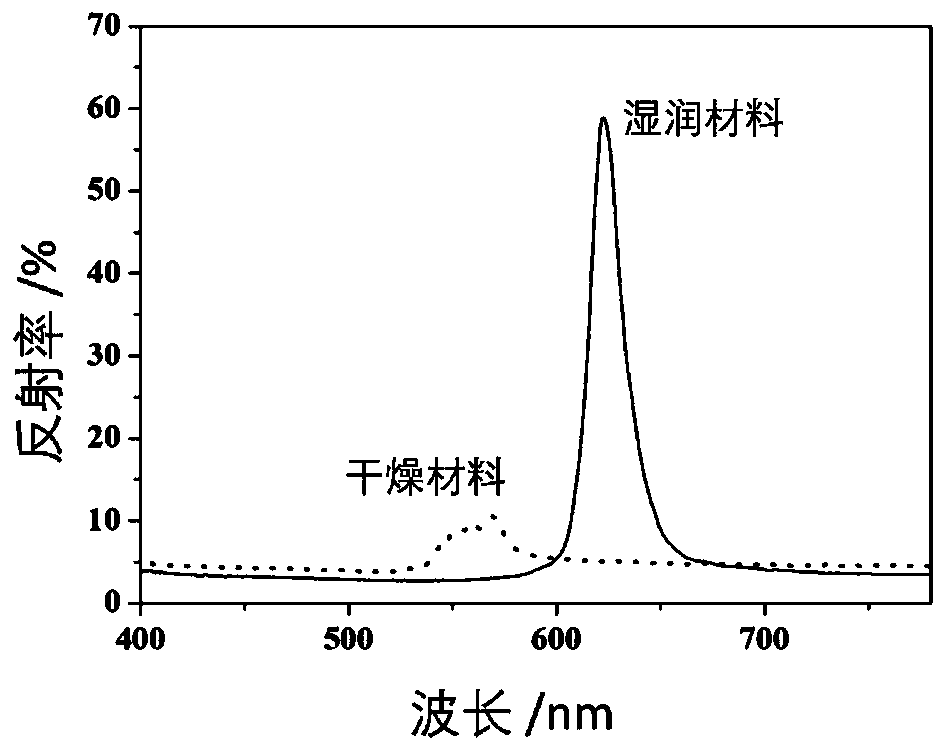Preparation method of photonic crystal material with excellent mechanical properties
A photonic crystal and performance technology, applied in the fields of polycrystalline material growth, chemical instruments and methods, nanotechnology for materials and surface science, etc. Simple process and uniform size
- Summary
- Abstract
- Description
- Claims
- Application Information
AI Technical Summary
Problems solved by technology
Method used
Image
Examples
Embodiment 1
[0077] The first step: 1 weight part of amphiphilic macromolecular reversible addition fragmentation chain transfer reagent (I) is stirred and dissolved in 2460 weight parts of water to form a water phase, and then poured together with the oil phase composed of 246 weight parts of styrene Stir in the reactor to mix. Raise the temperature of the reactor to 70°C, keep stirring, add 0.07 parts by weight of potassium persulfate after 30 minutes of nitrogen gas, and react for 10 hours to obtain R-AA n1 -b-St n2 -b-X n3 -Z polymer latex.
[0078] The second step: after the first step of reaction, add 166 parts by weight of n-butyl acrylate monomer, after 4.5 hours of reaction, add 215 parts by weight of n-butyl acrylate and 6 parts by weight of 1,4-butanediol Diacrylate, R-AA was obtained after continuing the reaction for 5 hours n1 -b-St n2 -b-St n3 -b-nBA n4 -Z polymer latex.
[0079] Step 3: Take 2 parts by weight of the amphiphilic macromolecular reversible addition frag...
Embodiment 2
[0091] Step 1: Stir and dissolve 1 part by weight of the amphiphilic macromolecular reversible addition-fragmentation chain transfer reagent (I) in 730 parts by weight of water to form a water phase, and pour it together with the oil phase composed of 70 parts by weight of styrene Stir in the reactor to mix. Raise the temperature of the reactor to 70°C, keep stirring, add 0.07 parts by weight of potassium persulfate after passing nitrogen for 30 minutes, and react for 4.5 hours to obtain R-AA n1 -b-St n2 -b-X n3 -Z polymer latex.
[0092] The second step: after the first step of reaction, add 50 parts by weight of n-butyl acrylate monomer, after 2.5 hours of reaction, add 60 parts by weight of n-butyl acrylate and 2 parts by weight of 1,4-butanediol Diacrylate, R-AA was obtained after continuing the reaction for 3 hours n1 -b-St n2 -b-St n3 -b-nBA n4 -Z polymer latex.
[0093] Step 3: Take 2 parts by weight of the amphiphilic macromolecular reversible addition fragment...
Embodiment 3
[0102] Step 1: Stir and dissolve 1 part by weight of the amphiphilic macromolecular reversible addition-fragmentation chain transfer reagent (I) in 10,000 parts by weight of water to form a water phase, and pour it together with an oil phase composed of 10 parts by weight of styrene Stir in the reactor to mix. Raise the temperature of the reactor to 70°C, keep stirring, add 0.2 parts by weight of potassium persulfate after passing nitrogen for 30 minutes, and react for 12 hours to obtain R-AA n1 -b-St n2 -b-X n3 -Z polymer latex.
[0103] Step 2: After the first step reaction, add 10 parts by weight of n-butyl acrylate monomer, and after 8 hours of reaction, add 1000 parts by weight of n-butyl acrylate and 30 parts by weight of 1,4-butanediol Diacrylate, R-AA was obtained after continuing the reaction for 10 hours n1 -b-St n2 -b-St n3 -b-nBA n4 -Z polymer latex.
[0104] Step 3: 10 parts by weight of the amphiphilic macromolecular reversible addition fragmentation chai...
PUM
| Property | Measurement | Unit |
|---|---|---|
| Tensile strength | aaaaa | aaaaa |
| Modulus | aaaaa | aaaaa |
Abstract
Description
Claims
Application Information
 Login to View More
Login to View More - Generate Ideas
- Intellectual Property
- Life Sciences
- Materials
- Tech Scout
- Unparalleled Data Quality
- Higher Quality Content
- 60% Fewer Hallucinations
Browse by: Latest US Patents, China's latest patents, Technical Efficacy Thesaurus, Application Domain, Technology Topic, Popular Technical Reports.
© 2025 PatSnap. All rights reserved.Legal|Privacy policy|Modern Slavery Act Transparency Statement|Sitemap|About US| Contact US: help@patsnap.com



